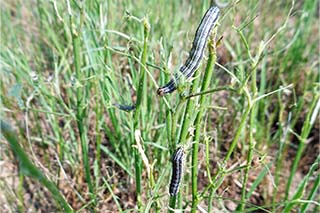Fall Armyworm
Sep 29, 2021

Fall armyworm are actively damaging grass fields, lawns, pastures, alfalfa fields, cover crops, and wheat fields. These newly seeded fields are seeing a complete loss in some scenarios as young seedlings aren't recovering from the feeding very well. The older, established fields of grass or alfalfa are getting fed on just as hard, but are expected to come back next spring. However, they potentially have much slower growth and less tonnage from the feeding.
Fall armyworms come from the south where they can overwinter in mild conditions. They fly as months and the southern winds push them into our geography. They do not overwinter in Nebraska and most years we don't see them in very high numbers. With the numbers we are seeing them in this year, this pest can decimate a field in a few days. Normal threshold limits are 1-3 sq/ft. We have seen quite a few fields with 10+ per sq/ft. Applying an insecticide needs to be done when the larvae are relatively small for best control and before they do much crop damage. We are having pretty good luck controlling these pests with timely application at a pt/acre of Lorsban.
Reach out to your local agronomist for more information.
Fall armyworms come from the south where they can overwinter in mild conditions. They fly as months and the southern winds push them into our geography. They do not overwinter in Nebraska and most years we don't see them in very high numbers. With the numbers we are seeing them in this year, this pest can decimate a field in a few days. Normal threshold limits are 1-3 sq/ft. We have seen quite a few fields with 10+ per sq/ft. Applying an insecticide needs to be done when the larvae are relatively small for best control and before they do much crop damage. We are having pretty good luck controlling these pests with timely application at a pt/acre of Lorsban.
Reach out to your local agronomist for more information.